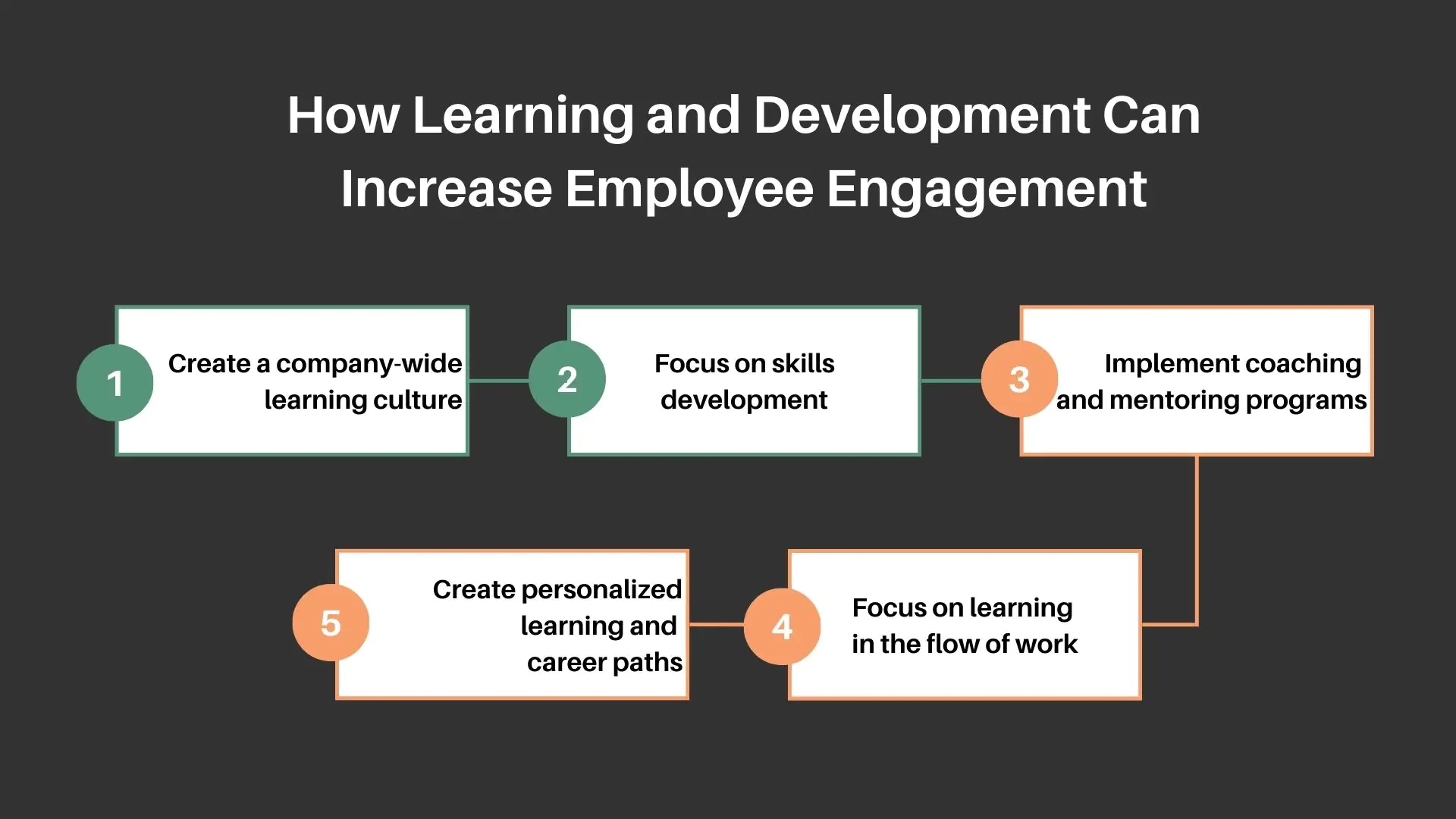The success of any educational initiative depends on how to engage employees in learning. The same applies to students. If your learners are disengaged, you may soon face various issues, such as decreased motivation, lower retention rates, increased frustration, and, ultimately, a decline in the effectiveness of your training program.
Highly engaged employees have proven to be 21% more profitable than disengaged employees, according to Forbes. If your students aren’t engaged in online courses, the popularity of your educational institution may soon decline. That’s because student engagement is a critical part of quality education.
So, how do you increase learner engagement in the learning process? Many organizations use eLearning and online training programs, yet their staff and students remain largely disengaged. If you’re one of them, here are some training engagement ideas.
1. Give Your Learners a Compelling Reason to Participate
A call to attend a corporate training program means that employees are expected to work differently in the future. That’s the major reason why employees resist change, demonstrating personal frustration and low productivity. Often, front-line employees believe that the company organizes learning sessions just for the sake of it or perceive ‘improvements’ as a justification for staff positions.
To avoid this resistance, you need to explain to your employees the consequences of not switching to better procedures or methods. Unless they are not dissatisfied with the current practices, there’s no way to motivate the employees to embrace change. To make sure that they see the limitations of existing methods, consider creating a psychological dilemma.
Likewise, to encourage student engagement, educational institutions must provide course objectives and learning outcomes beforehand so that students know how it will benefit them.
Demonstrating the Value of Learning
Explain how the learning program and the overall change can improve their skills and foster personal growth. Let them know how the modules in the training program will help them achieve their career goals. When employees can see how an eLearning course can add value to their professional career, they’re more likely to stay motivated to attend the course and demonstrate engagement in the learning process.
2. Deliver Interactive and Relevant Learning Content
While this one is obvious, many organizations still fall short in ensuring intractability and relevance in their online course. They nail the ‘interactive’ part but fail on the ‘relevance’ front, resulting in a disengaging course. According to the 2016 Emerging Workforce Study, 45% of the surveyed employees said that their existing training programs are not relevant to the work they do every day.
Before anything else, it’s important to understand the clear difference between the terms ‘interactive’ and ‘engaging.’ An interactive learning module works like an application, requiring users to select options, choose the next actions, and interact in other ways while taking the course. On the other hand, a course that’s also engaging will keep the users engrossed and spark interest, motivating them to complete it. An interactive eLearning course is not necessarily engaging if it’s not relevant to the users or fails to leverage engaging content.
Hence, increasing the learner engagement process involves presenting the content and subject matter of your eLearning course in a way that resonates with the learners. Organizations should focus on offering relevant interactive training to their learners to better engage them and assist them in meeting their career development needs.
One great strategy is to include conversation simulations and video content that focus on the unique aspects of an employee’s role. You have numerous other format options to do this, including podcasts, webcasts, infographics, and animations. These formats are particularly effective in making courses more engaging.
Engage with Visuals
Besides relevance, your eLearning course should also be rich in graphic content. The visual elements of your course are crucial in making it more effective and engaging. According to Buffer, 65% of users are visual learners. Plus, visual content processes 60,000 times faster in learners than plain text. Moreover, you may have heard that people retain only 10% of what they hear, 20% of what they read, but a staggering 80% of what they see.
Keeping these facts in mind, consider using a combination of visuals and text in your online learning course. These are among the most effective ideas to make courses more engaging. Raccoon Gang can help you create this type of content easily and without any hassles.
3. Integrate Real-life Scenarios Into eLearning Programs
An online learning course that reflects employees’ real-life work situations should foster more engagement in the learning process than other training types. This way, employees would also be able to immediately apply their learning to their daily jobs. This allows for better information retention and skill development for learners. With work-related scenarios, learners are more likely to complete the course too as they can see the relevance of the course to their everyday work.
So, how do you integrate real-life scenarios into training programs? A useful approach is to keep your learners’ contexts in mind when developing an online course. This should open up several ideas for you. For example, instead of relying on hypothetical situations, include scenarios that are more reflective of the issues employees commonly encounter at the workplace. When you do that, employees will feel they’re getting the insights and help they need, sparking engagement in the learning process.
Taking into account learners’ contexts also means that you use graphics similar to how the real work environment looks like and include characteristics that your employees usually possess. In addition, customize your course based on the learners’ language, culture, and learning preferences.
Examples
For instance, you can include three different conversations in an eLearning scenario, each of which shows a different way to handle a difficult customer. Once the learners observe all three conversations, you can ask which method of communication with the customer is ideal in the depicted scenario.
Another way to ensure that your course mimics real-life situations is to time the course to create a sense of urgency and pressure. In the real world, employees don’t have all the time in the world to make decisions. Thus, your eLearning course should encourage learners to make choices under pressure. As long as your course doesn’t build up too much pressure, a reasonably time-bound course will increase engagement in the learning process.
4. Use Mobile Learning
With a massive increase in smartphone penetration around the world, L&D departments have already started engaging employees through mobile learning. Given the usage trend of smart devices among millennials, engaging students in learning should be easy using mobile learning. You can either use a blended approach to incorporate mobile into your existing learning strategy or deliver it in the form of dedicated microlearning.
Mobile learning makes courses more engaging in various ways. Since learners can quickly access the course on their mobile devices, they remain consistent in attending the modules of the course. Whether they’re commuting to work or having their lunch, they can quickly start from where they left and thus, complete the course more quickly than otherwise. The employee downtime is also greatly reduced.
On top of that, you’re able to provide a new, more engaging learning experience by leveraging the newest capabilities of the smartphone platform. The best eLearning apps allow learners to download and save learning content on their mobile devices and consume it when convenient.
You might be thinking about how the results will be tracked when a learner takes the course offline. Results and performance of learners are recorded offline and transferred onto the LMS as soon as the device reconnects to the internet. Given that you use the right content, your learners will gain a truly engaging mobile experience.
5. Use Gamification Strategies in Course Design
One of the most popular ideas to increase engagement in the learning process is to gamify your course. Gamification refers to using game-based thinking, mechanics, and aesthetics to design eLearning programs. You need to apply digital game design techniques and game elements to real-life problems featured in an online course.
The reason why gamification is one of the most effective techniques is that it was solely developed to improve user engagement. Learners welcome it because it incorporates fun into their learning journey. It makes use of techniques intended to tap users’ natural desires for competition, socializing, mastery, achievement, learning, status, self-expression, and more.
However, it’s important to understand that gamification is not a game. Since it doesn’t require learners to play games, gamified learning courses are not full-fledged games. They simply comprise game elements and mechanics to make the same day-to-day activities more engaging and compelling, increasing engagement in the learning process. The use of game elements is not so concentrated that it creates a game for the learning content. Gamification shouldn’t steal the show by replacing learning with gaming, enhancing learner engagement.
The most common game elements include:
Virtual Scenarios
Adding simulation elements are a great way to capture your learners’ interest in the eLearning course. One idea is to allow your learners to navigate scenarios in varying environments. You may create several thoughtful scenarios based on what appeals to your learners. Once they’ve completed each scenario, they should be able to see the results and try again if they aren’t happy with the outcome.
Leaderboards
We’ve grown up earning high scores in games. Whether it’s about beating others’ records or surpassing one’s high score, the drive to meet the set benchmarks proves highly motivating for learners. To create a sense of competition in quizzes and tests, you can incorporate leaderboards wherever you want.
However, don’t make a permanent leaderboard. It can demotivate learners who don’t score well in the early stages. A wiser decision would be to create weekly or monthly leaderboards. This way, every learner will have a chance to lead once the period ends and the high-scoring learners will stay motivated to defend their position.
Points and Currency
Points are another great way to engage your learners and can be used in the form of currency in the course. You can use a point system to encourage learners to advance in the course, finish a lesson or module, or win badges. To get them started, grant a few points for filling out the profile or logging in certain times a day. You can even give out points for adding a comment in the community forum. The earned points can be redeemed to obtain discounts or other rewards.
Badges
Badges are a recognized way to foster user engagement in areas beyond the eLearning context. Not only are they part of popular video games, but many other applications also use them to reward users. In eLearning, you can use them to encourage learners to use different functions on the eLearning platform, acquire new skills, help other users, etc.
As users accomplish targets, allow them to level up certain badges. As opposed to leaderboard scores, badges remain permanent so that consistent top performers get a sense of achievement.
While these are some of the gaming elements you can use to engage learners in your eLearning modules, keep in mind that gamification extends well beyond these. The best gamified online course will focus more on the content and internal factors than the external ones. Your gamified eLearning course shouldn’t be about collecting points for the sake of earning badges. While these elements can be used to get things running in the beginning, the real motivation should ultimately be to learn and acquire skills.
Final Word
These were some ideas to increase engagement in the learning process. If you’re looking to develop a highly engaging eLearning course, Racсoon Gang can help you with it. We’ve been shaping the 21st-century eLearning trends with our innovative course designs. Using the Open edX LMS to build online courses, we develop each component while keeping learner engagement in mind.
To obtain a quote for your planned project, fill out this form.







